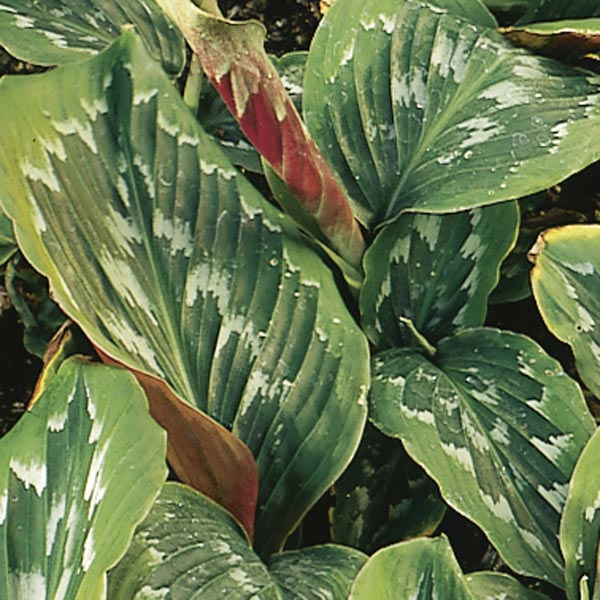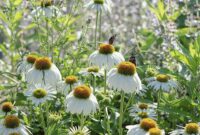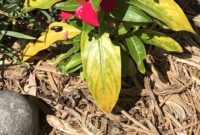I. Introduction
Peacock ginger plants, scientifically known as Kaempferia spp., are a captivating addition to any garden or indoor space.
These plants are renowned for their striking foliage that resembles the vibrant plumage of peacocks, making them a favorite among plant enthusiasts.
If you’re a beginner looking to cultivate these unique and exotic plants, this guide will walk you through the essential care steps to ensure your peacock ginger thrives.
II. Getting Started
When it comes to successfully growing peacock ginger, the journey begins with selecting the right location and preparing the soil. Here’s what you need to know:
Choosing the Right Location
Selecting an appropriate location for your peacock ginger plants is crucial for their well-being. These plants thrive in specific environmental conditions, and choosing the right spot will contribute significantly to their growth and vibrancy.
- Partial Shade: Peacock ginger plants prefer dappled sunlight or partial shade. Avoid placing them in direct sunlight, as this can scorch their delicate leaves. Morning sun or filtered light through trees is ideal.
- Moisture Levels: The chosen location should provide consistent moisture without waterlogging. Well-draining soil is essential to prevent root rot, which can be fatal to your plants.
Soil Preparation and Ideal Soil Conditions
Once you’ve identified the perfect spot, it’s time to prepare the soil. Peacock ginger plants have specific soil preferences that cater to their needs.
- Well-Draining Soil: Peacock ginger thrives in well-draining soil. To enhance drainage, consider mixing in organic matter such as compost or peat moss. This will also improve the soil’s fertility and moisture retention.
- Acidic to Neutral pH: Aim for a slightly acidic to neutral pH range in your soil, ideally between 5.5 to 7.0. You can test the soil’s pH using a soil testing kit available at most garden centers.
- Mulching: Applying a layer of organic mulch around the base of your peacock ginger plants can help maintain soil moisture levels and deter weeds.
By giving careful consideration to your plant’s location and soil conditions, you set the stage for healthy and thriving peacock ginger.
In the following sections, we’ll delve deeper into the various aspects of caring for these remarkable plants, including planting, watering, sunlight, feeding, pruning, and troubleshooting common issues.
Let’s embark on your journey to becoming a successful peacock ginger plant caregiver.
III. Incorporating Peacock Ginger into Your Garden
Designing with Peacock Ginger
Peacock ginger plants are not only admired for their beautiful foliage but also for their ability to enhance the overall aesthetics of your garden. Here are some creative ideas on how to design with peacock ginger:
1. Focal Points:
Use peacock ginger as a focal point in your garden. Plant them in clusters or as a border around other plants to draw attention to their vibrant foliage.
2. Under Trees:
Take advantage of their preference for partial shade by planting peacock ginger beneath taller trees. This creates a lush, tropical look and provides a sense of coolness in the garden.
3. Mixing Colors:
Consider planting different peacock ginger varieties with varying leaf colors to add depth and contrast to your garden design. Some varieties have green leaves, while others have reddish or purplish tones.
Complementing with Other Plants and Landscaping Elements
To make the most of your peacock ginger, it’s essential to complement them with suitable companion plants and landscaping elements:
1. Shade-Loving Plants:
Pair peacock ginger with other shade-loving plants like ferns, hostas, or caladiums. This combination creates a harmonious and visually appealing shade garden.
2. Stone Pathways:
Install stone pathways or stepping stones to create a serene walkway through your garden. Plant peacock ginger alongside these pathways to add a touch of exotic beauty.
3. Water Features:
Consider adding a small water feature like a fountain or pond nearby. The sound of flowing water combined with the lush greenery of peacock ginger creates a tranquil atmosphere.
By thoughtfully incorporating peacock ginger into your garden and complementing them with other plants and landscaping elements, you can transform your outdoor space into a stunning and inviting oasis.
IV. Container Gardening with Peacock Ginger
Creating Stunning Container Gardens with Peacock Ginger
If you have limited garden space or prefer gardening indoors, peacock ginger is an excellent choice for container gardening. Here’s how to create a captivating container garden with these vibrant plants:
1. Selecting Suitable Containers
Choose containers that are spacious enough to accommodate the root system of your peacock ginger plant. Opt for pots with drainage holes to ensure proper water drainage.
2. Arrangements and Placement
- Plant one peacock ginger rhizome per pot to allow ample space for growth.
- Consider combining peacock ginger with other shade-loving container plants like ferns, begonias, or impatiens for a visually appealing arrangement.
- Position the containers in areas with filtered or indirect sunlight to replicate their preferred growing conditions.
3. Care and Maintenance
Container gardening with peacock ginger requires attention to detail:
- Regularly water your peacock ginger when the top inch of soil feels dry, but avoid overwatering to prevent root rot.
- Fertilize your plants with a balanced, water-soluble fertilizer during the growing season to promote healthy foliage.
- Prune dead or yellowing leaves to maintain the plant’s appearance and health.
- Repot your peacock ginger every couple of years to refresh the soil and provide more space for growth.
Container gardening with peacock ginger allows you to enjoy their beauty on patios, balconies, or even indoors, making them a versatile and captivating addition to your plant collection.
With these ideas and tips, you can incorporate peacock ginger into your garden or create stunning container gardens that showcase the unique beauty of these plants. Whether in the garden or on your patio, peacock ginger is sure to add a touch of exotic charm to your space.
V. Creating Tropical Vibes Indoors
Growing Peacock Ginger Indoors
Peacock ginger’s lush and exotic appearance makes it an excellent choice for bringing a touch of the tropics into your indoor spaces. Here’s how you can successfully grow peacock ginger indoors:
1. Selecting the Right Indoor Location
Choose a well-lit indoor location that receives filtered or indirect sunlight. Place your peacock ginger away from direct sunlight, which can scorch its delicate leaves. Ideal spots include:
- Near east or west-facing windows where it can receive gentle morning or afternoon sunlight.
- In a room with bright, filtered light, such as a conservatory or a room with sheer curtains.
2. Choosing Decorative Pots
Select decorative pots or containers that complement your indoor decor while providing adequate space for the plant’s growth. Ensure the pots have drainage holes to prevent overwatering.
3. Potting Mix and Soil
Use a well-draining potting mix that replicates the peacock ginger’s preferred soil conditions. A mix containing perlite, peat moss, and sand works well. Ensure the soil remains consistently moist but not waterlogged.
4. Humidity and Temperature
Peacock ginger plants thrive in humid conditions. Increase humidity levels by misting the plant regularly or placing a humidity tray nearby. Maintain indoor temperatures between 65°F to 75°F (18°C to 24°C).
5. Watering
Keep the soil consistently moist but avoid soggy conditions. Water your indoor peacock ginger when the top inch of soil feels dry. Ensure that excess water drains out of the pot, and avoid letting the plant sit in standing water.
6. Fertilizing
Feed your indoor peacock ginger with a balanced, water-soluble fertilizer every 4-6 weeks during the growing season (spring to early autumn). Reduce fertilization during the winter months when growth slows down.
7. Pruning and Maintenance
Trim dead or yellowing leaves to maintain the plant’s appearance and overall health. Remove spent flowers to encourage new growth.
8. Repotting
Repot your indoor peacock ginger every 2-3 years or when it becomes root-bound. This allows for fresh soil and more room for growth.
By following these indoor care considerations, you can enjoy the lush and tropical appearance of peacock ginger within the comfort of your home.
With the right care and attention, your indoor peacock ginger can thrive and become a captivating centerpiece in your interior decor, bringing a slice of the tropics to your living space.
VI. Using Peacock Ginger in Floral Arrangements
Cutting and Incorporating Peacock Ginger Flowers
Peacock ginger not only adds elegance to your garden but also brings a unique touch to floral arrangements. Its striking flowers, which resemble peacock feathers, can be a captivating addition to bouquets and displays.
Here’s how to cut and incorporate peacock ginger flowers into your floral arrangements:
1. Timing and Selection
Selecting the Right Time: The ideal time to cut peacock ginger flowers is when they are in full bloom. Look for flowers with vibrant colors and unblemished petals. Generally, the flowering period for peacock ginger is during the warmer months, such as late spring through summer.
2. Cutting and Handling
Use Sharp, Clean Shears: Before cutting, ensure your shears or scissors are clean and sharp. This minimizes damage to the plant and ensures a clean cut.
Cut at an Angle: When cutting the flowers, do so at a slight angle. This allows for better water absorption and helps the flowers stay fresh longer.
Place in Water Immediately: Immediately place the cut peacock ginger flowers in a container with water. This prevents wilting and helps the flowers stay hydrated.
3. Preparing the Arrangement
Choose Complementary Flowers: Consider the color and style of the peacock ginger flowers when selecting other flowers for your arrangement. They pair well with tropical blooms like orchids, anthuriums, and heliconias.
Balancing the Arrangement: Create balance by adding greenery, filler flowers, and other elements like ferns or palm leaves. This will enhance the overall look and feel of the arrangement.
4. Arranging with Peacock Ginger
Central or Focal Point: Position one or more peacock ginger flowers as the central or focal point of your arrangement. Their unique appearance makes them an excellent choice to draw attention.
Texture and Contrast: Use the peacock ginger flowers to add texture and contrast to your arrangement. Their spiky petals and vibrant colors can provide a striking contrast to other softer flowers.
Height and Structure: Experiment with the height and structure of your arrangement. Peacock ginger flowers work well in both tall and compact arrangements, depending on the desired effect.
5. Maintenance
Water: Ensure the vase or container is regularly topped up with clean water to keep the flowers hydrated.
Trim Stems: Trim the stems of the peacock ginger and other flowers every few days to promote water uptake and maintain freshness.
By incorporating peacock ginger flowers into your floral arrangements, you can create captivating displays that showcase their unique beauty.
Whether for special occasions or simply to bring a touch of the exotic into your home, these flowers can add a delightful and distinctive element to your floral compositions.
.
.
.
.
.
Source image: https://mygardenlife.com/plant-library/peacock-ginger-kaempferia-hybrid



